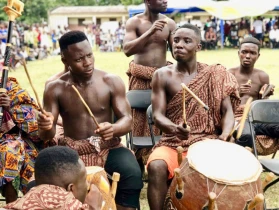Stories and facts
The Sacred Grove of Tano, located in the Brong-Ahafo Region of Ghana, is a site of immense historical and cultural significance.
The grove is dedicated to the Tano River deity, an important spiritual figure in the traditional beliefs of the Akan people. It is revered as a sacred space where the divine and the earthly intersect, reflecting the deep-rooted spiritual traditions of the region.
The Sacred Grove of Tano has been a center of religious and cultural activities for centuries. It is believed that the grove has been a place of worship and ritual since the early settlements of the Akan people in the area. The site is associated with the Tano River, which is considered a sacred entity and is central to the religious practices of the local communities.
The Tano Grove is not only a natural haven but also a spiritual sanctuary. It is traditionally regarded as a place where offerings and sacrifices are made to honor the Tano deity, who is believed to protect the community and ensure prosperity. The grove is used for various rites and ceremonies, including prayers, rituals, and festivals that are integral to the spiritual life of the Akan people.
The sacredness of the grove is reflected in its well-preserved natural environment, which is carefully maintained to preserve its spiritual sanctity. The grove is characterized by dense forest, ancient trees, and a serene atmosphere that enhances its spiritual significance. Access to the grove is usually restricted to ritual specialists and members of the local community, emphasizing its sacred status.
Throughout history, the Sacred Grove of Tano has faced various challenges, including pressures from modernization and environmental changes. Despite these challenges, efforts have been made to preserve the cultural and spiritual heritage of the grove. Local authorities and traditional leaders have worked to ensure that the site remains protected and that its significance is maintained for future generations.
The grove is also a symbol of the resilience of traditional practices in the face of modernization. It serves as a reminder of the rich cultural heritage of Ghana and the importance of preserving traditional beliefs and practices.
In recent years, the Sacred Grove of Tano has gained recognition as an important cultural and historical site. It has attracted interest from scholars, tourists, and cultural enthusiasts who seek to understand and appreciate the traditional practices of the Akan people. The site contributes to the broader understanding of Ghana's cultural and religious history and highlights the value of preserving indigenous traditions.
Today, the Sacred Grove of Tano stands as a testament to the enduring spiritual and cultural heritage of the Akan people. It continues to be a focal point for traditional rituals and cultural celebrations, playing a vital role in the preservation of Ghana’s rich cultural tapestry.






